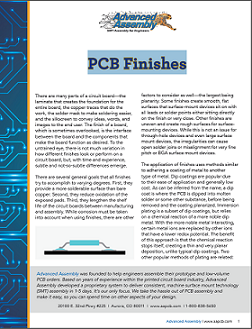
There are many parts of a circuit board—the laminate that creates the foundation for the entire board, the copper traces that do the work, the solder mask to make soldering easier, and the silkscreen to convey ideas, words, and images to the end user. The finish of a board, which is sometimes overlooked, is the interface between the board and the components that make the board function as desired. To the untrained eye, there is not much variation in how different finishes look or perform on a circuit board, but, with time and experience, subtle and not-so-subtle differences emerge.
There are several general goals that all finishes try to accomplish to varying degrees. First, they provide a more solderable surface than bare copper. Second, they reduce oxidation of the exposed pads. Third, they lengthen the shelf life of the circuit boards between manufacturing and assembly. While corrosion must be taken into account when using finishes, there are other factors to consider as well—the largest being planarity. Some finishes create smooth, flat surfaces that surface-mount devices sit on with all leads or solder points either sitting directly on the finish or very close. Other finishes are uneven and create rough surfaces for surface mounting devices. While this is not an issue for through-hole devices and even large surface mount devices, the irregularities can cause open solder joins or misalignment for very fine pitch or BGA surface mount devices.
Advertisement
Learn more about Advanced Assembly





